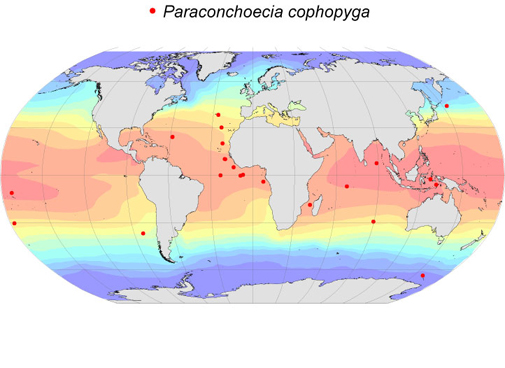Atlas of Atlantic Ostracods
Taxon details
Paraconchoecia cophopyga (Müller, G.W., 1906)
- Order:
- MYODOCOPA
- Suborder:
- Halocypridina
- Family:
- Halocyprididae
- Subfamily:
- Conchoecinae
- Size range (females):
- 3.1-3.2 mm
- Size range (males):
- 3 mm
- Depth:
- bathypelagic
Notes
24 records
This is an uncommon bathypelagic species with a broad scattering of records throughout all oceans, mostly at latitudes <30°. Müller (1906) placed it in his ‘dentata group’ remarking on its resemblance to P. oblonga, P. spinifera and P. echinata. Consequently Poulsen (1973) classified it in Paraconchoecia, when he re-established Claus’s genus. However, together with its smaller sibling species P. dentata, it exhibits a number of significant differences, for example only two the terminal setae on the sixth limb of the male are long, and exceptionally on the first antenna the b-seta is the longest seta, longer than the e-seta. So probably these two species P. cophopyga and P. dentata should be classified in a separate genus. cophopyga is a deep bathypelagic species living at depths of 1500-3000m. Müller (1906) recorded it at a few stations close to the Equator in the Atlantic and Indian Oceans and Poulsen (1973) at four stations in the Pacific. Chavtur (1977) has recorded it from 45°N in the north Pacific, and more recently (2003) from 64°S to the south of Australia. There are too few records from the Discovery transect to plot meaningful profiles.
| N.Atlantic | n | Mean mm | s.d. | Range mm |
|---|---|---|---|---|
| Female | 13 | 3.11 | 0.076 | 2.92-3.20 |
| Male | 8 | 3.03 | 0.048 | 2.96-3.08 |
| A-1 | 4 | 2.40 | 2.30-2.52 | |
| A-2 | 3 | 1.60 | 1.54-1.64 |




